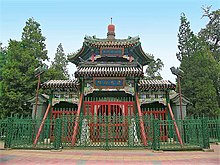
Back مسجد نيوجيه Arabic مسجد نيوجيه ARZ Нюцзе мәсете Bashkir নিউজিয়ে মসজিদ Bengali/Bangla Mešita Niou-ťie Czech Niujie-Moschee German Moskeo Njuĝjie Esperanto Mezquita de Niujie Spanish مسجد نیوجی Persian Niujien moskeija Finnish
This article needs additional citations for verification. (December 2012) |
| مسجد نيوجيه Niujie Mosque | |
|---|---|
牛街清真寺 Niú Jiē Qīng Zhēn Sì | |
 | |
| Religion | |
| Affiliation | Sunni Islam |
| Location | |
| Location | Niujie, Xicheng, Beijing, China |
| Geographic coordinates | 39°53′04″N 116°21′29″E / 39.88444°N 116.35806°E |
| Architecture | |
| Type | mosque |
| Style | Chinese |
| Groundbreaking | 996 |
| Capacity | 1,000 worshipers |
The Niujie Mosque[1][2][3] (simplified Chinese: 牛街礼拜寺; traditional Chinese: 牛街禮拜寺; pinyin: Niú Jiē Lǐ Bài Sì; Wade–Giles: Niu-chieh Li-pai-ssu "Oxen Street House of Worship" or Chinese: 牛街清真寺; pinyin: Niú Jiē Qīng Zhēn Sì; Wade–Giles: Niu-chieh Ch'ing-chen-ssu "Oxen Street Mosque") is the oldest mosque in Beijing, China. It was first built in 996 during the Liao dynasty and was reconstructed as well as enlarged under the Kangxi Emperor (r. 1661–1722) of the Qing dynasty.[4]
The mosque is located in the Niujie area of Beijing's Xicheng District, the spiritual centre for the 10,000 Muslims living in the vicinity and it is the biggest and oldest one in Beijing. It was within the Xuanwu District before it merged into Xicheng in 2010. Niujie in Xicheng District, where the mosque is located, is the largest area inhabited by Muslims in Beijing.
The Niujie Mosque covers an area of approximately 10,000 square meters. The mosque reflects a mixture of Islamic and Han Chinese cultural and architectural influences. From the outside, its architecture shows traditional Chinese influence and the inside has a blend of Islamic calligraphy and Chinese design. The main prayer hall is 600 square meters in area, and can hold more than 1,000 worshipers. The mosque, built out of timber, is home to some important cultural relics and tablets such as the upright tablet of an emperor's decree proclaimed in 1694 during the Qing dynasty.
- ^ Cite error: The named reference
:0was invoked but never defined (see the help page). - ^ Cite error: The named reference
:1was invoked but never defined (see the help page). - ^ Cite error: The named reference
:2was invoked but never defined (see the help page). - ^ "Restorations: Olympic Torch Or Rural Touch?". China Heritage Quarterly. Retrieved 28 October 2012.
